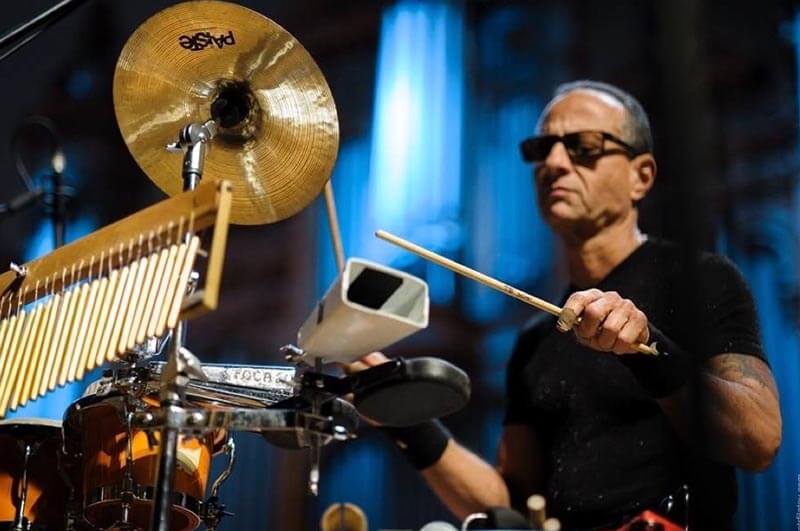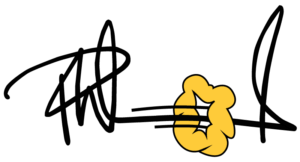Julio Diniz
I have great pleasure in presenting this interview with Julio Diniz – Indian Clubs Brazil, which was conducted and translated by Frank Colón for me to share with you.
Julio Diniz – Indian Clubs Brazil
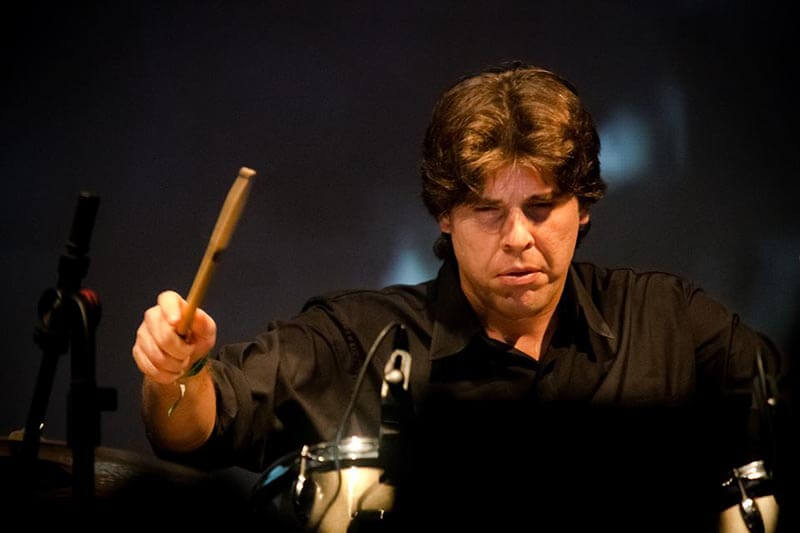 Originally from Rio de Janeiro, Brazil, Julio Diniz is a young, up-and-coming professional musician active on the national performance and recording scene. As such, he has contributed his talents as a drummer and percussionist to the music of João Donato, Marcos Valle, Robertinho Silva, Tulio Mourão, Selma Reis, Rubão Sabino, João Sabia and is frequently called on for recording soundtracks for Globo Television, Brazil’s top media conglomerate.
Originally from Rio de Janeiro, Brazil, Julio Diniz is a young, up-and-coming professional musician active on the national performance and recording scene. As such, he has contributed his talents as a drummer and percussionist to the music of João Donato, Marcos Valle, Robertinho Silva, Tulio Mourão, Selma Reis, Rubão Sabino, João Sabia and is frequently called on for recording soundtracks for Globo Television, Brazil’s top media conglomerate.
FC- So, Julio, when did you start swinging Indian Clubs, man?
Julio Diniz:- The way that I got into Indian Clubs was through an unexpected surprise discovery. I was actually surfing the web looking for information about kettlebells, as I had been introduced recently by a close friend. So, searching the internet for new information about kettlebells, I found some information about these things called Jori, from India, and also about Indian Clubs. The first videos about clubs were by Andreas Vogelsang and Paul Taras Wolkowinski. So, I was attracted to the movements they were doing… I thought they were cool!
FC- And…when was this? …do you remember…?
Julio Diniz:- This must have been about two-and-a-half years ago, or so… It was around April or May of 2014, I think… because this is the time that I had just been introduced to the Kettlebell and to that whole world of the Russian Soviet Special Forces training methods. I liked how they used these simple iron tools for improving the self-defence skills of their elite combat guys. And, since I’ve always liked training martial arts, this appealed to me immediately.
You know, nowadays, when one is looking up a certain topic on the internet or on YouTube, a whole list of other topics that may or may not be related to one’s own search show up, right? So, all of a sudden, these videos from Paul Taras Wolkowinski and Andreas Vogelsang began appearing… so I checked them out and got more and more interested in the traditional old-school Indian workout methods.
Then, I found some videos of this guy called Pratyay Singh… and he was in India, working out with Jori and Gada (Maces)… and then.. there was this guy, Paul, again… and he was working out with Pratyay…in India! And, there were some other guys in India using these things… I don’t remember their names…
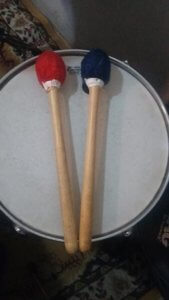 So, I started to practice with drum mallets… the ones that we use for the big samba surdo drums. I liked the movement, I found a website that showed how to make these weighted clubs out of plastic bottles filled with gravel… so, I made some.
So, I started to practice with drum mallets… the ones that we use for the big samba surdo drums. I liked the movement, I found a website that showed how to make these weighted clubs out of plastic bottles filled with gravel… so, I made some. 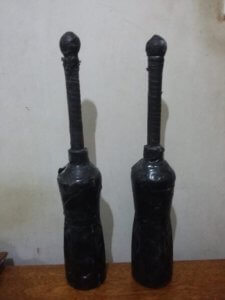 And, they were heavy and hard to swing…! I remember that I took them over to show my friend and he didn’t like them, at all! But, that same day, we sat down to find a wood-turning machine in Rio, because I was going to make some professional clubs! It was then, that we found out about Andreas Vogelsang and his hand-carved Cobbett-Jenkin sized clubs. It was a different game from that point on, as my friend got the fever and hand-carved himself some clubs and some 4.5 kg meels, as I carved myself two pairs of clubs.
And, they were heavy and hard to swing…! I remember that I took them over to show my friend and he didn’t like them, at all! But, that same day, we sat down to find a wood-turning machine in Rio, because I was going to make some professional clubs! It was then, that we found out about Andreas Vogelsang and his hand-carved Cobbett-Jenkin sized clubs. It was a different game from that point on, as my friend got the fever and hand-carved himself some clubs and some 4.5 kg meels, as I carved myself two pairs of clubs.
FC- Were you already connected to these people through Facebook? Did you know about them already?
Julio Diniz:- No, no… I had never heard of them before. Like I said…I was looking for information on Kettlebells….
FC- …probably looking for stuff on Pavel
(Pavel Tsatsouline is credited as being the person who introduced the kettlebells to the western world. A former Master Trainer of the Soviet Spetznaz, this guy’s the real deal!!)
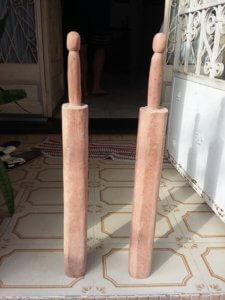 JD- Right! Pavel! You know, I used to stay up hours at night watching some DVD videos of Pavel… I learned a lot of good lessons about stretching and proper lifting technique. I learned most of the basic kettlebell swings – the Snatch, the Long Cycle, the Turkish Get Up – from Pavel’s tutorials. And, I still use the kettlebell regularly, as I feel that it leaves one feeling “compact”… you know? This is how I feel it. Now, with the clubs, I feel that they demand a different kind of concentration… plus there’s a coordination factor that must be learned, that’s very different from the lifting of a kettlebell.
JD- Right! Pavel! You know, I used to stay up hours at night watching some DVD videos of Pavel… I learned a lot of good lessons about stretching and proper lifting technique. I learned most of the basic kettlebell swings – the Snatch, the Long Cycle, the Turkish Get Up – from Pavel’s tutorials. And, I still use the kettlebell regularly, as I feel that it leaves one feeling “compact”… you know? This is how I feel it. Now, with the clubs, I feel that they demand a different kind of concentration… plus there’s a coordination factor that must be learned, that’s very different from the lifting of a kettlebell.
FC- …I was just about to ask you, “What do you like more about Indian Clubs as compared to kettlebells?”
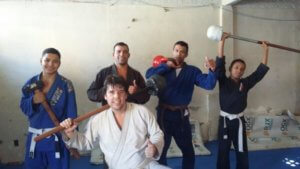 Julio Diniz:- What I really like is the concentration that one has to do in order to coordinate the inner and outer circles that one does on different sides of one’s body. One has many more possibilities for movements with clubs rather than with kettlebells. The clubs give me a feeling of ecstasy, perhaps due to their flow and non-stop movement. The club’s circularity is what seduces me… to me
Julio Diniz:- What I really like is the concentration that one has to do in order to coordinate the inner and outer circles that one does on different sides of one’s body. One has many more possibilities for movements with clubs rather than with kettlebells. The clubs give me a feeling of ecstasy, perhaps due to their flow and non-stop movement. The club’s circularity is what seduces me… to me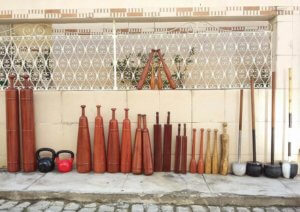 , it’s similar to the mental “chess game” that goes on during the practice of Jiu-Jitsu… especially when one trains while wearing a gi (the traditional Japanese martial arts training uniform), which affords unlimited possibilities for innovative rolling and immobilization techniques. New people coming into the sport of Jiu-Jitsu are going to invent new ways of solving the many challenges of personal self-defence and this keeps the sport fresh… which is something that I see with club swinging, this is the same with drum rudiments, with the majority of them originating from either the double-stroke rolls or the paradiddles…from mastering these, one breaks free to improvise at will!
, it’s similar to the mental “chess game” that goes on during the practice of Jiu-Jitsu… especially when one trains while wearing a gi (the traditional Japanese martial arts training uniform), which affords unlimited possibilities for innovative rolling and immobilization techniques. New people coming into the sport of Jiu-Jitsu are going to invent new ways of solving the many challenges of personal self-defence and this keeps the sport fresh… which is something that I see with club swinging, this is the same with drum rudiments, with the majority of them originating from either the double-stroke rolls or the paradiddles…from mastering these, one breaks free to improvise at will!
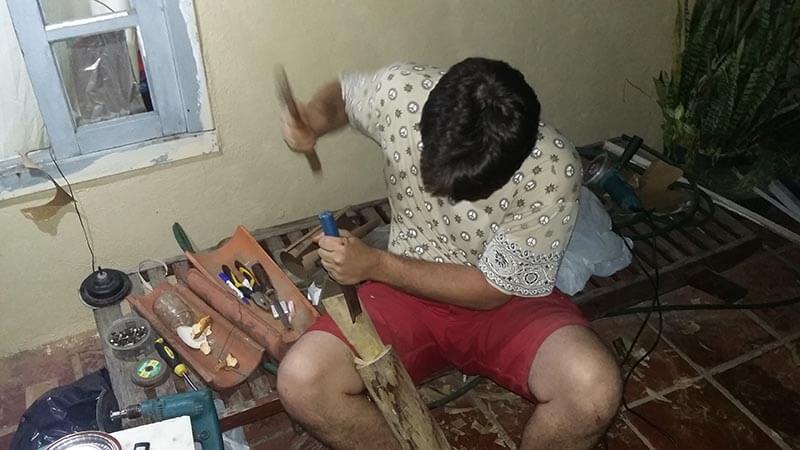 While I’m relatively “new” at club swinging, having started with this only two-and-a-half years ago, I really like this Community of Club and Meel Swingers and I appreciate their coaching and comments! During the many long hours of training I have always followed the principles shared by Paul Wolkowinski in that, “…there are two basic movements:-
While I’m relatively “new” at club swinging, having started with this only two-and-a-half years ago, I really like this Community of Club and Meel Swingers and I appreciate their coaching and comments! During the many long hours of training I have always followed the principles shared by Paul Wolkowinski in that, “…there are two basic movements:-
- Circles going out and away from the body’s centre axis
- Circles coming in towards the body’s central axis
From these two fundamental movements, one is able to transition into all of the other ones. I think that there must be an infinite number of combinations, right?
FC- Do you prefer swinging Indian Clubs one or two-handed?
Julio Diniz:- Well… look… if I use just one club, I will, most likely, choose to practice routines that involve the entire body. If on the other hand, I feel like swinging two clubs, then I’ll practice techniques that don’t use the legs. Although, there are a few routines that I’m discovering which have lateral leg extensions in combination with swinging two clubs. One must coordinate the upper circling with the lateral and lowering movements so that one doesn’t hit oneself in the leg or scrape the floor with the clubs.
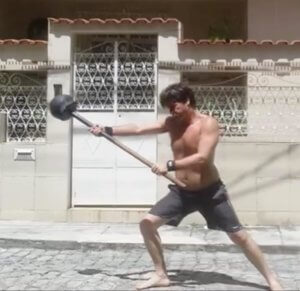 This takes some mental division and one must coordinate the body as if it was a mechanism with moving parts that must sync together. Depending on the circle, you would be doing an outward upward circle with your left arm, for example… and you’d be doing two circles with your right hand – a small mill in front of the body and another behind your waist – setting yourself up to reverse everything into a parallel loop in towards the central axis… so, then… how does one really visualize this?
This takes some mental division and one must coordinate the body as if it was a mechanism with moving parts that must sync together. Depending on the circle, you would be doing an outward upward circle with your left arm, for example… and you’d be doing two circles with your right hand – a small mill in front of the body and another behind your waist – setting yourself up to reverse everything into a parallel loop in towards the central axis… so, then… how does one really visualize this?
But, the thing is, the clubs take you there, naturally. Once you dominate the basic circles, the clubs lead you on to new combinations.
FC- If you were to be cast away alone on a desert island, which pair of Indian Clubs would you choose to have with you?
Julio Diniz:- Oh, man, I would take those new ones that weigh one kilo. You know, the ones with the light-coloured wood, and the sabre handle with the “hat” button! I like those because, even though they’re not heavy, one “feels” them after a short while and they’ve got enough weight so as to mix well with some total-body exercises.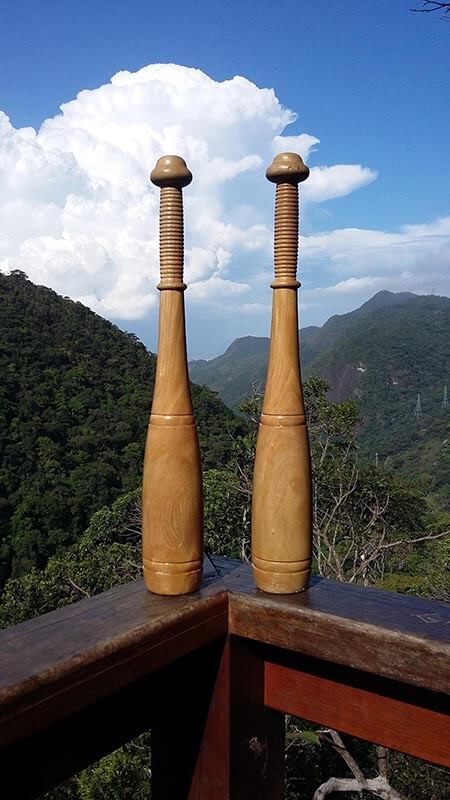
FC- Which leads me right into……what are the characteristics of your favourite Indian Clubs?
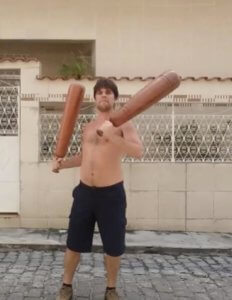 Julio Diniz:- The things on a club that I need to feel comfortable with are the handle and the “end button”. My hands sweat a lot…. so what happened with some of the clubs that I sculpted and with some other ones that I bought (…I had some baseball bats that I found online here in Brazil modified into clubs…!) was that they flew out of my hands! But, it was mainly because of the varnish on them.
Julio Diniz:- The things on a club that I need to feel comfortable with are the handle and the “end button”. My hands sweat a lot…. so what happened with some of the clubs that I sculpted and with some other ones that I bought (…I had some baseball bats that I found online here in Brazil modified into clubs…!) was that they flew out of my hands! But, it was mainly because of the varnish on them.
So, I’m preferring – and, even Helder Gandra suggested this, as well! – not to varnish my clubs. And, this is why I had those grooves carved into the sabre handles of those new blond clubs that I just had made. Besides, I like the handle to be 2.5 cm thick. And, as for the knob, I prefer either a sphere or a mushroom-like shape… so, for this new pair of clubs, I attempted to design a “spherical mushroom” (“laughs”) and I’m happy with the way it turned out! But, for the next one, I may reduce the size of the knob button…just a little bit…because this was an experiment….
These clubs have become my favourite, beginning from the fact that I found this wood in the street. A big tree had fallen in my neighbourhood, a victim of an all-night thunderstorm. When I saw the tree on the ground, all broken up, I managed to carry a thick branch away. It was still raining, so I got home all muddied and soaking wet! The next day, I took off the bark and let the branch dry for a few more days. I then took the branch over to our wood-turning artist, Mr Zôsimo, who was really surprised at the quality of the wood! He said that it was “Madeira de Lei” (“Noble Wood”), apparently from a tree called Ipê Branco, which is very rare nowadays. Consequently, Mr Zôsimo was thrilled to work with this wood, and he did a great job in sculpting these clubs!
However, getting back to your question concerning which pair of clubs I would like to have with me on a desert island…. the truth is I’d rather take all of my clubs and meels and tie them together into a raft… and then paddle out to that deserted island and stay there training for a while! (“laughs”) But, if I could only take one pair, then I would choose those blond clubs.
FC- Why did you decide to become an Indian Club trainer?
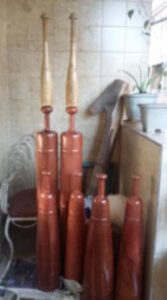 Julio Diniz:- This is because I, myself, have benefitted a lot from practising club-swinging. This sport has improved my posture…..I used to feel some aches and pains in my lower back which I don’t feel any more since I took up the regular practice of Indian Clubs. The kettlebell lifts have also helped… and, I think that clubs and kettlebells are a good combination. The kettlebells have really strengthened my back! And the clubs have improved my posture and coordination plus helped me lose weight.
Julio Diniz:- This is because I, myself, have benefitted a lot from practising club-swinging. This sport has improved my posture…..I used to feel some aches and pains in my lower back which I don’t feel any more since I took up the regular practice of Indian Clubs. The kettlebell lifts have also helped… and, I think that clubs and kettlebells are a good combination. The kettlebells have really strengthened my back! And the clubs have improved my posture and coordination plus helped me lose weight.
I used to weigh 116 kilos and now, thanks to the regular practice of club-swinging, meels, and gada training, I now weigh 91 – 92 kilos. And I can lift more weight now… I feel more flexible and I know that my blood circulation has improved…and, strange as it may seem… I mean, you know that I’m a musician, right?
Well, I feel that club-swinging is helping me with my music performance ability, in the sense of improved coordination as well as attention. Because one needs a high degree of concentration when swinging clubs…besides needing stamina. And, one needs good technique, because if you try to swing the clubs with an aggressive attitude, you’re destined for failure.
FC- How do you combine Indian Clubs in combination with other training?
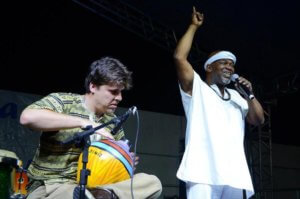 Julio Diniz:- Lately, I’ve only been training with Indian Clubs, Gada, and Persian Meels. Oh, and kettlebells, too! I like to train with the kettlebell before doing gada or meels exercises, as I think this warms up the whole body really well before going for the meels. I use the clubs more independently…On the day that I dedicate more to the clubs, I also like to train push-ups with ab exercises. I feel that the kettlebells stress out the whole body, so I go light with them when I use them as a warm-up for turning meels. But, I’ve also been adding squats to my club sessions, as a way to exercise my legs.
Julio Diniz:- Lately, I’ve only been training with Indian Clubs, Gada, and Persian Meels. Oh, and kettlebells, too! I like to train with the kettlebell before doing gada or meels exercises, as I think this warms up the whole body really well before going for the meels. I use the clubs more independently…On the day that I dedicate more to the clubs, I also like to train push-ups with ab exercises. I feel that the kettlebells stress out the whole body, so I go light with them when I use them as a warm-up for turning meels. But, I’ve also been adding squats to my club sessions, as a way to exercise my legs.
FC- Out of all the old books written about Indian Clubs, which one is your favourite and why?
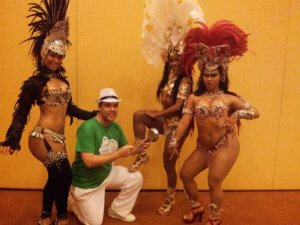 Julio Diniz:- Well, I’ve just begun reading one from 1905 by Cobbett & Jenkin…. as Helder Gandra indicated this book to me! Because almost all of what I practice I have learned from studying the examples on Paul Taras Wolkowinski’s site. I was able to translate the instructions given with the video examples and the written explanations and trained from this.
Julio Diniz:- Well, I’ve just begun reading one from 1905 by Cobbett & Jenkin…. as Helder Gandra indicated this book to me! Because almost all of what I practice I have learned from studying the examples on Paul Taras Wolkowinski’s site. I was able to translate the instructions given with the video examples and the written explanations and trained from this.
I also found videos on YouTube by Andreas Vogelsang and more by Paul….. but, most of the instructions that I followed were from Paul’s site….but, I also came across the Zurkhaneh site, which offered some serious information! The Zurkhaneh Sports Federation… you know….they offer quite a bit of material if you dig in… and then, I discovered good videos by Steve Angell… and then, I began trading information with Helder via Facebook, and checking out his videos… but, I can say that my foundation was built around the online instruction offered by Paul and Andreas! It’s only now, that I’m beginning to read these old books on the subject, thanks to an app that scans text and produces an instant translation.
FC- Is there anything else you would like to share?
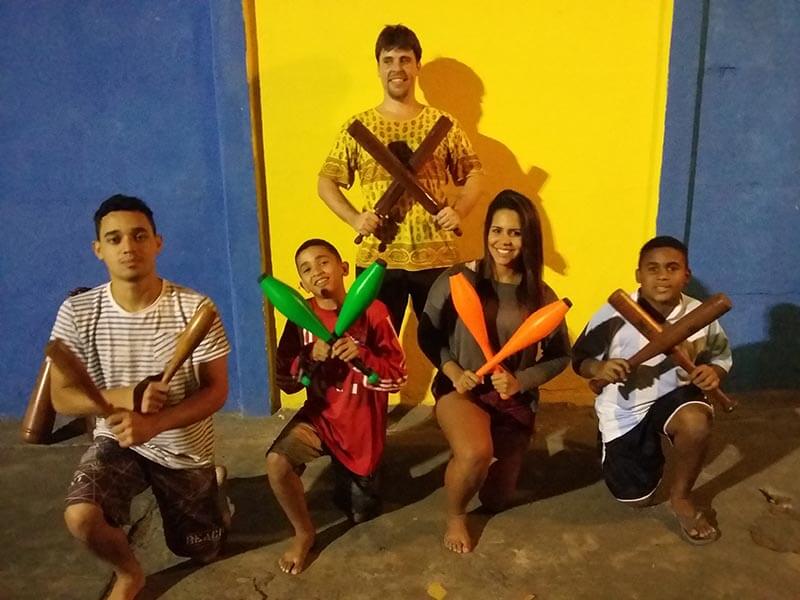 Julio Diniz:- I believe that everybody would benefit from swinging clubs, no matter what age they are! And, I think that, as we age, we can benefit even more from the movements because…speaking of myself, I can now move my arms in ways that I didn’t even know was possible a couple of years ago.
Julio Diniz:- I believe that everybody would benefit from swinging clubs, no matter what age they are! And, I think that, as we age, we can benefit even more from the movements because…speaking of myself, I can now move my arms in ways that I didn’t even know was possible a couple of years ago.
I think that it would be interesting if club swinging was incorporated into the Physical Education departments of primary, middle and high schools, throughout the local and state educational systems.
FC- Is this what your Projeto Social (“Social Project”) was about?
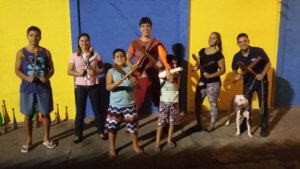 Julio Diniz:- Yes. It was about this concept. It’s about spreading the sport of club swinging to the youth of my neighbourhood and then have it spread out through the city.
Julio Diniz:- Yes. It was about this concept. It’s about spreading the sport of club swinging to the youth of my neighbourhood and then have it spread out through the city.
FC- Did you train regularly with these children?
Julio Diniz:- We trained every week. There were between eight and twelve kids per class, as they were also Jiu-Jitsu students who train with a Rio de Janeiro champion who’s a life-long friend of mine. (My friend’s nickname is “Macarrão”, which means…”Spaghetti”! I think he got this name for being so “slippery” on the Jiu-Jitsu mat!) I did this on my own, without any municipal or private support. The program is now suspended on account of my enrolling back in school, as I pursue a degree in Physical Education. But, there are videos on YouTube of these kids swinging clubs!
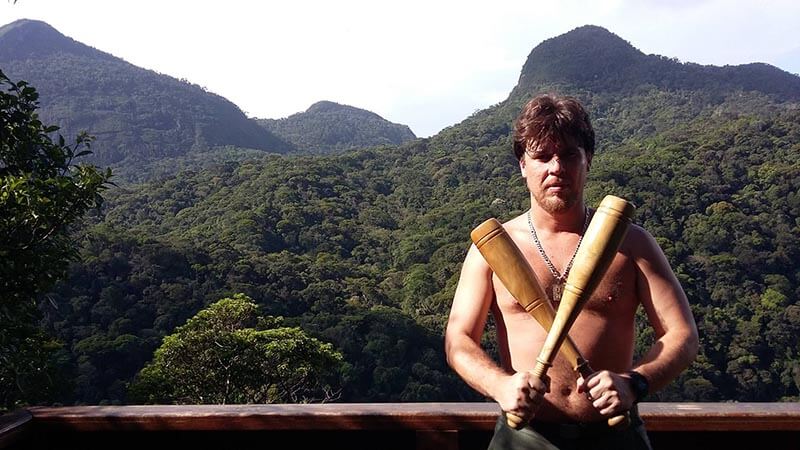
FC- Thanks for your time, Julio!
Julio Diniz:- Swinging clubs has become an important part of my lifestyle. I know that I’ll be training and improving myself with the Gada, Meels and Indian Clubs for the rest of my life. Thank you for this opportunity to tell my story.
Facebook – https://www.facebook.com/Indian-Clubs-Brasil-1562088340707921/
The Facebook site is the most active, real-time internet presence, and it is constantly updated. Please contact us first via our Facebook Page.
YouTube – https://www.youtube.com/user/dinizdotambor
Website – www.indianclubsbrazil.com
The Indian Clubs Brazil website, while just beginning, is designed to be a constant work-in-progress. The purpose of the site is to offer an abundance of didactical information on Indian Clubs to the people of Brazil and South America.
Email address – diniz_perc@hotmail.com
Frank Colón
Frank Colón website:- http://www.frankcolon.com/
Percussion You’ll Remember Forever!®
